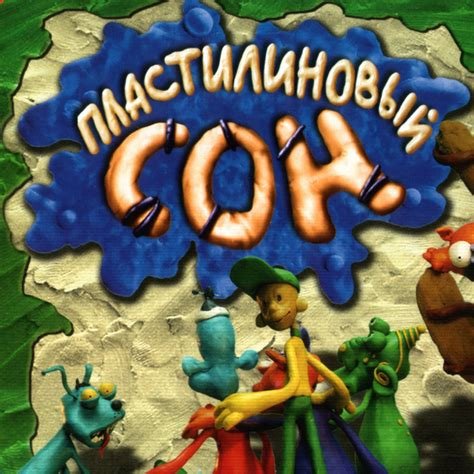- Release Year: 2002
- Platforms: Windows
- Publisher: 1C Company
- Developer: Avalon Style Entertainment
- Genre: Adventure
- Perspective: 3rd-person (Other)
- Game Mode: Single-player
- Gameplay: Puzzle elements
- Setting: Fantasy dream world
- Average Score: 68/100

Description
Plastilinovyj Son is a humorous point-and-click adventure game where all characters, backgrounds, and objects are crafted from plasticine and filmed as live video. The game is set in a fantasy dream world threatened by the evil Daydream, who shattered the Dream Crystal into six shards hidden in the dreams of a single family. Players control Ruff, a good Dream, as he navigates through six unique dreams to recover the shards without waking the dreamers.
Plastilinovyj Son: Review
Introduction
Plastilinovyj Son, released in 2002, is a charming point-and-click adventure game that stands out for its unique claymation aesthetic. Crafted by Avalon Style Entertainment and published by 1C Company, the game transports players into a dreamy realm where all characters and environments are made of plasticine. While it shares similarities with earlier claymation games like Neverhood, Plastilinovyj Son carves its own niche with a fantasy narrative centered around dreams and crystals. Despite mixed reviews at launch, the game’s distinctive visuals and whimsical atmosphere have earned it a cult following among adventure game enthusiasts.
Development History & Context
Plastilinovyj Son emerged in an era where point-and-click adventures were facing competition from newer, more action-oriented game genres. However, its innovative claymation approach harked back to the heyday of adventure games while adding a fresh visual twist. The development team at Avalon Style Entertainment set out to create a dreamlike world using stop-motion techniques, capturing each frame as live video. This allowed for incredibly detailed and tactile environments, though it also presented technological challenges in terms of rendering and frame rates. The game’s release came at a time when similar claymation titles had already made waves, but Plastilinovyj Son’s focus on a fantasy dreamworld and puzzle-based gameplay aimed to distinguish it from the pack.
Narrative & Thematic Deep Dive
The story of Plastilinovyj Son revolves around Ruff, a noble Dream creature tasked with restoring the shattered Dream Crystal by collecting its six shards from the dreams of a single family. Each family member’s dream is a distinct world, reflecting their personality and desires. The boy dreams of lunar adventures and alien encounters, symbolizing childhood curiosity and wonder. The cat’s dream, filled with dogs and mice, taps into primal instincts and survival. The grandfather’s fishing dreams recall simpler times and nature’s tranquility. These varied dreamscapes serve as more than just backdrops; they underscore the theme of how individual dreams contribute to the collective dream reality. The evil Daydream’s act of destruction represents chaos undermining harmony, setting the stage for Ruff’s quest to restore balance. However, critics noted that the narrative lacks the depth and humor present in earlier claymation games, leaving players wanting more emotional investment.
Gameplay Mechanics & Systems
At its core, Plastilinovyj Son follows the classic point-and-click adventure formula, focusing on puzzle solving and exploration. Players guide Ruff through each dream world, interacting with objects and characters to collect the crystal shards. The game employs a verb-based interface, allowing actions like “take,” “use,” and “talk.” Inventory management plays a crucial role as players collect items needed to solve puzzles. The gameplay is generally straightforward, with puzzles that range from simple to moderately challenging. However, some critics found the game too short for its two-CD release, with around 40 locations and puzzles that didn’t offer enough variety or depth. The control scheme is responsive enough, but the game’s pre-rendered video visuals can sometimes make it difficult to spot clickable areas. Overall, the gameplay delivers a satisfying experience for fans of the genre but may not offer enough longevity for others.
World-Building, Art & Sound
The game’s art direction is its crowning achievement. The claymation style, with its vibrant colors and textured surfaces, creates a mesmerizingly tactile world. Each dream environment is meticulously crafted, from the boy’s moonbase with aliens to the cat’s urban jungle filled with canine predators. The attention to detail in the models and set pieces is commendable, even if the frame rate of the video occasionally stutters. The sound design complements the visuals with a dreamy, atmospheric soundtrack that evokes a sense of wonder and urgency. Sound effects are subtle yet effective, often using the muffled, squishy sounds of clay to enhance the game’s unique aesthetic. However, the voice acting (if present) might be limited, given the game’s focus on visual storytelling. retVal*>(()())>
Reception & Legacy
Upon release, Plastilinovyj Son received mixed reviews. IGROMANIA awarded it 75%, praising its visuals but lamenting the lack of humor and shallow gameplay. Igray.ru gave it a lower 60%, criticizing the game’s brevity and limited appeal outside claymation enthusiasts. Player ratings are sparse, averaging 3.5 out of 5. The game’s legacy is somewhat overshadowed by its predecessors like Neverhood, which had more robust gameplay and humor. Despite this, Plastilinovyj Son has maintained a cult following, particularly among those appreciative of its unique art style and the labor-intensive process behind its creation. It stands as a notable example of how innovative presentation can elevate a game, even if its gameplay doesn’t break new ground.
Conclusion
Plastilinovyj Son is a visually stunning adventure game that captivates with its claymation wonder but falls short in gameplay depth and narrative richness. While its art direction and atmosphere are undeniably enchanting, the game’s limited puzzle variety and brevity may leave players yearning for more substance. As a curious footnote in video game history, it’s a title that deserves a look from fans of unique game aesthetics and point-and-click adventure classics.RetVal*(()())>